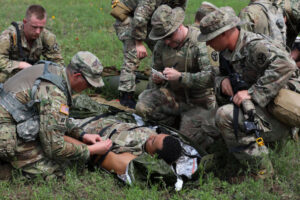
Story by Spc. Grayson Cavaliere
118th Mobile Public Affairs Detachment, Tennessee Army National Guard
FORT CAVAZOS, TEXAS — Soldiers from Tennessee National Guard’s 278th Armored Cavalry Regiment, NATO Allies, and service members from the Navy and Air Force participated in a Joint Emergency Medicine Exercise June 6, 2024.
Participants joined together and responded to several emergency combat scenarios, with multi-lateral shared knowledge, skill-building, and experience in a simulated high-stress combat environment.
U.S. Army National Guard Lt. Col. Thad Snyder, Brigade Surgeon of the 278th, followed along as Soldiers participated in medical lanes, and watched as they received enemy contact and applied life-saving techniques to patients.
“The lane is designed for knowing how to take care of a person who’s been injured while in a combat environment,” said Snyder. “What’s unique within this environment is that it changes how you render treatment. This particular lane is about getting the patient out of harm’s way. Once you get them into a space that is afar, you can then start to render additional forms of treatment.”
Soldiers began the exercise on standard patrol, receiving enemy contact at unexpected times and from a variety of enemy forces. Snyder believes this type of realistic joint training builds lethality within the Allied forces.
“My number one goal, first and foremost, is to give Tennessee medics and Tennessee Soldiers more experience in life saving procedures on and off the battlefield,” said Snyder. “There’s going to be a need for every Soldier to have a wider level of experience, regardless of what the future holds, in training and medicine.”
One of those Soldiers, Spc. Andrew Hermon, a combat medic from 278th medical detachment, Charlie Troop, Regimental Support Squadron, is taking full advantage of the joint training, learning as much as possible from the wealth of knowledge shared during the exercise.
“I’ve noticed a lot of situations you’ll have multiple ways of doing something, and then a provider will have a better outcome or way of doing something that’s quicker and more effective,” said Hermon. “Maybe as a combat medic you know more of the tactical side, and the providers don’t because they’re doing hospitals and clinics and such.”
The exercise is particularly helpful for Soldiers because it simulates care during multiple stages of combat and engagement, while also providing a chance to learn medicine and tactics from providers, special operations, and Allied forces.
“The entire exercise is incredibly beneficial for all roles in the medical field and for understanding the important role each member has in combat situations,” said Hermon. “If someone goes down, being able to communicate is very important. I noticed our first couple of lanes were a little rough. Then as we progressed through and understood how to work as a team, it went a lot better and a lot smoother.”
After the Soldiers completed the lane, they had a chance to receive feedback from special forces, providers, and nurses who oversaw all points of the exercise.
“It is a unique experience,” said Hermon. “We were able to work with and alongside other U.S. Military branches and Allied partner forces. Like I said before, getting everyone to work on the same page is the best way to get a better outcome for the patients.”
The transfer of knowledge goes both ways. While Soldiers are getting valuable experiences from more experienced providers, those physicians are also learning tactical medical care from Soldiers.
“It gives you a sampling of what it’s like to work with a physician, with a nurse, with a medic and all these different skillsets get introduced to medical care, right where the injury occurs,” said Snyder. “That mixture gives perspective to a wide variety of providers who may not experience this but have an idea of what the Soldier experiences firsthand.”
Combat medics and other Soldiers from the 278th will continue to train over the course of June, refining their skills and preparing for future deployments.
“My number one thing is the enthusiasm from all the Soldiers I’ve seen participating—which has been outstanding,” said Snyder. “I’ve seen several who may not have a medical background, show keen interest understanding the value of additional medical training.”
With the training completed for the day, Snyder has one extra piece of advice for Soldiers and those who strive for excellence:
“I think people should try as hard as they can and fail—because we learn more from our failures than our successes,” said Snyder. “We want to train as hard as we can, and fail when we train, so that way we don’t fail when the real time comes. Because those lessons will be remembered.”